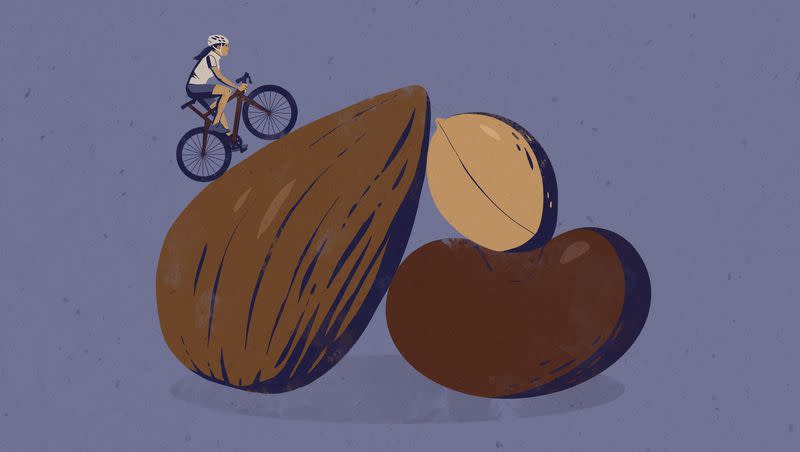Opinion: The American protein obsession is an answer in search of a problem

I’m a vegetarian. Contrary to common belief, my diet varies greatly from that of the average American rabbit. I’m regularly asked if it’s difficult to get enough protein without meat, and yet I sometimes wonder how much we really understand about where protein comes from.
I once attended an event where dinner was provided, and I was told that there would be a vegetarian substitute for the meat. I held back a giggle when I was presented with a plate of sliced cucumbers as the vegetarian substitute. Not only did I feel like I was being handed an extra cup of water, I wondered how a cucumber, basically nonexistent in calories and protein, was considered an equal counterpart to meat.
The juxtaposition of copious concern for my protein intake paired with an apparent misunderstanding of what foods qualify as protein has taken me into a deep dive on protein myths, legends and buried truths.
You don’t need as much protein as you think
If you’ve been to an American grocery store, you’ve seen the signs of our obsession in the marketing: protein toaster waffles, protein chocolate chip cookies, protein nacho cheese chips, protein spaghetti noodles. I was recently affronted by a high protein reproduction of a Hostess Ding Dong.
Where do we draw the line?
Yes, protein is a vital macronutrient essential to our survival. Insufficient protein can lead to malnutrition, weakened immune response, stunted growth in children and various other health issues.
Sounds concerning, but here’s the catch.
The average adult in Western countries consumes twice the estimated protein requirement, according to a literature review published in 2019 in the journal Nutrients. Vegetarians in Western countries often have a lower protein intake than meat eaters, but their average intake is still considered “much higher than the Recommended Dietary Allowance.”
Related
In 2021, GoodRx Health reported the same finding, stating that despite our protein obsession, Americans are getting double what we need. Protein deficiency in the U.S. is rare and often due to calorie deficiency; “if you’re eating enough calories, you’re probably naturally eating enough protein.”
Riding the protein obsession, a GQ journalist decided to eat only Halo Top ice cream — a product loaded up with protein — for 10 days straight in 2016, as highlighted on the podcast “Maintenance Phase.” He calculated that by eating five pints daily, he could get 120 grams of protein a day. After cataloging a host of side effects and annoyances, including an ever-growing canker sore and headaches, he reported that he would not likely be doing the Halo Top diet again. “The problem here isn’t that it’s ice cream,” says “Maintenance Phase” co-host Aubrey Gordon, “the problem is that he’s only eating one food.”
Halo Top might have more protein, but as co-host Michael Hobbs points out, “There’s no lack of protein in the American diet, but we’ve been told over and over again that we need to be eating as much protein as humanly possible.”
You should also know what you’re paying for. And that’s air. Halo Top weighs 256 grams, while its counterpart Ben & Jerry’s weighs 428 grams, as reported by Time. So while you got your protein, you just paid for extra air.
How to get protein without the protein cookie
“When we talk about protein, we are dissociating the nutrient from its food source,” David L. Katz, an American doctor and public health scholar told The Guardian. The phenomenon he is referring to is our affinity for protein powders and foods that have been pumped up with unnecessary added proteins (see aforementioned protein Ding Dong). Instead, we could be getting our protein from naturally protein-rich foods and allowing a cookie to just be a cookie.
Aside from meat, there are plenty of plants prepared to be your power food. The literature review states that “traditional legumes, nuts and seeds, are sufficient to achieve full protein adequacy in adults.”
Related
Per Healthline, lentils have 17.86 grams per cup. Black and pinto beans, about 15.41 grams. Peas, 8.58 grams. Quinoa, 8.14 grams. Brussel sprouts, 5.64 grams. And a medium broccoli stalk has 4.28 grams. This is just a small sampling of the larger pantry of protein-rich foods. If we eat a variety of foods in a day, we will naturally consume the protein our bodies need, no powders necessary.
If you enjoy your high-protein ice cream more than a classic scoop of Tillamook, I’m not here to tell you not to eat it. As Gordon puts it, “Totally eat what you want, but please don’t conflate marketing with nutritional education.” We all deserve to know that our anxieties over protein deficiency are most likely a nonissue. You can serve chili for dinner without feeling pressured to purchase the “protein packed cornbread mix.”
